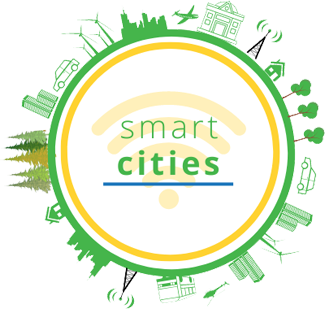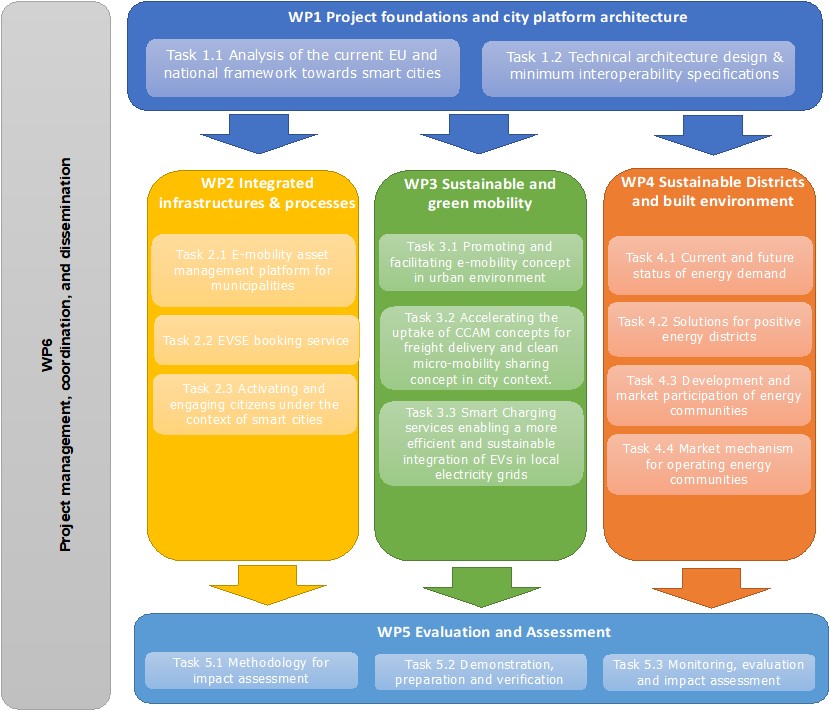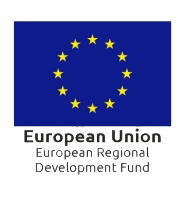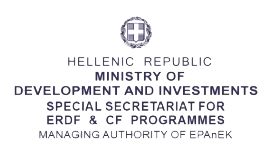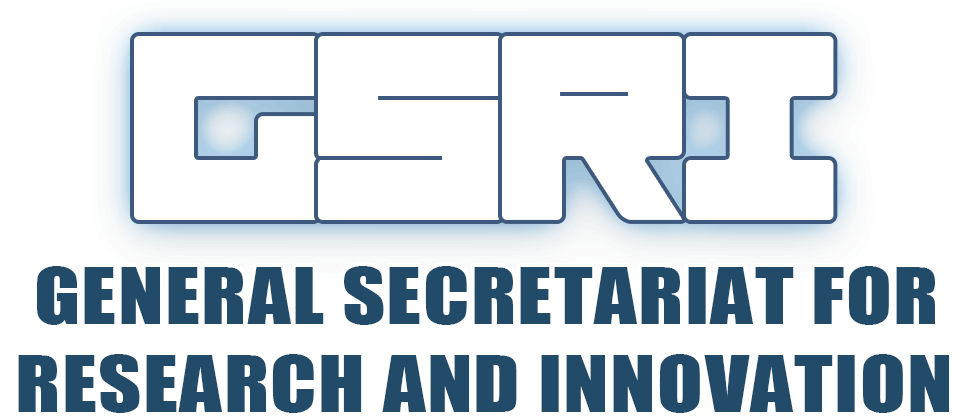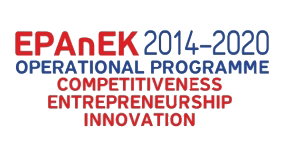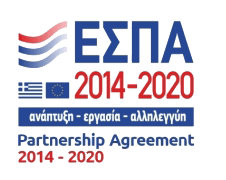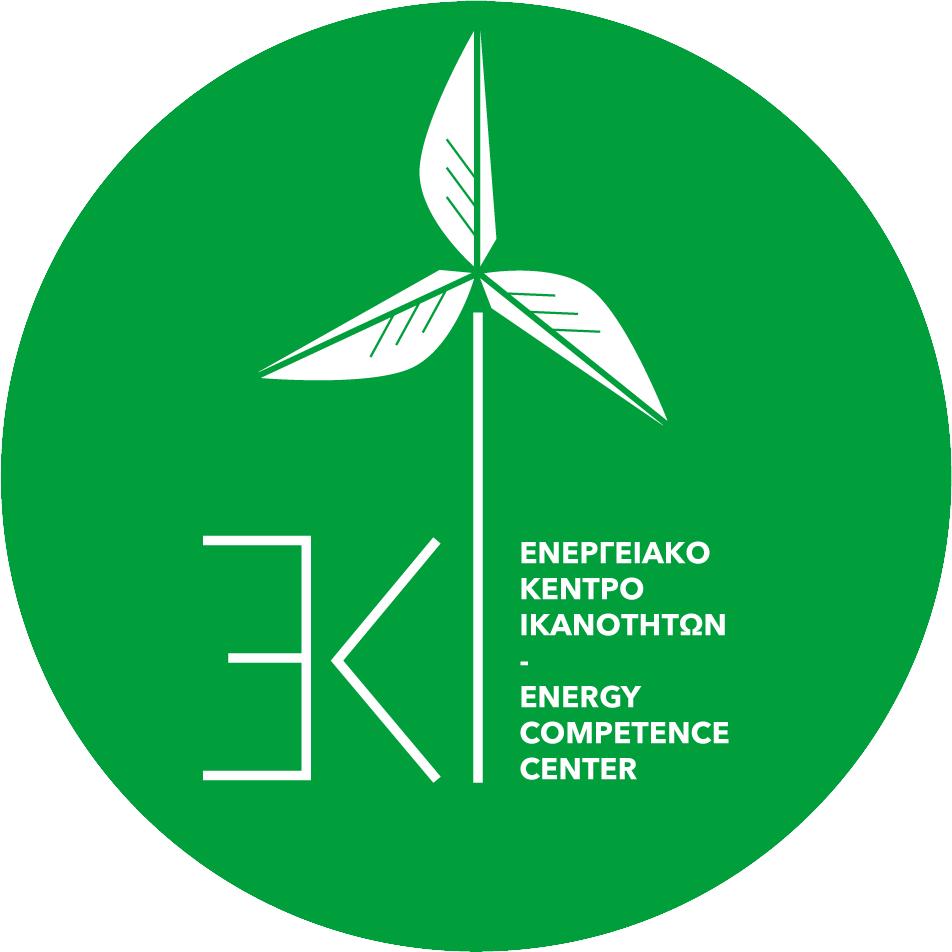Work Units
Driving Progress, Work Unit by Work Unit: Achieving Results and Advancing Together
01.
Project foundations and city platform architecture:
Building on Strong Foundations, Empowering Cities through Platform Architecture
Task 1.1 Analysis of the current EU and national framework towards smart cities
By critically assessing the alignment between EU directives and national strategies, this analysis aims to identify gaps, challenges, and opportunities in the path towards achieving smart city objectives.
Through a thorough examination of legal, governance, and financial aspects, this analysis provides insights into the effectiveness and coherence of the current framework, facilitating informed decision-making and policy adjustments for realizing the vision of smarter, more sustainable cities in the European context.
Task 1.2 Technical Architecture Design & Minimum Interoperability Specifications
The technical architecture design involves developing a robust framework that outlines the structure, components, and interfaces of interconnected systems, ensuring compatibility and scalability.
Simultaneously, minimum interoperability specifications define the essential requirements and standards for data exchange, communication protocols, and interoperability among different components.
By adhering to these specifications, organizations can establish a common language and framework for interoperability, facilitating the smooth flow of information and services.
This approach promotes efficient system integration, enables flexibility for future enhancements, and encourages innovation through the integration of emerging technologies.
Ultimately, technical architecture design and minimum interoperability specifications lay the groundwork for building interconnected and future-ready systems that can seamlessly collaborate, leading to improved efficiency, enhanced user experiences, and accelerated digital transformation.
Work Unit Deliverables:
- Analysis of the current EU and national framework towards smart cities
- Technical architecture design and minimum interoperability specifications
02.
Intergrated Infrastructure & Processes:
Empowering Efficiency, Resilience, and Sustainable Progress through Integrated Infrastructure and Processes
Task 2.1 E-Mobility asset mαnagement platform for municipalities
By leveraging advanced technologies such as IoT, data analytics, and real-time monitoring, this platform enables municipalities to efficiently track and maintain charging stations, monitor energy consumption, and analyze usage patterns.
It facilitates seamless coordination between various stakeholders, including local authorities, energy providers, and service operators, ensuring the availability, reliability, and scalability of e-mobility services.
With the ability to monitor performance, perform remote diagnostics, and implement intelligent charging strategies, this platform empowers municipalities to create a robust and sustainable e-mobility ecosystem that supports the transition towards greener and more efficient transportation.
Task 2.2 ESVE Booking services
With this platform, users can easily locate available charging stations, view real-time availability, and make reservations in advance, ensuring that a charging spot is ready when needed.
The ESVE Booking services streamline the charging process, allowing users to efficiently plan their charging activities, avoid waiting times, and optimize their charging schedules.
Additionally, the platform offers features such as payment integration, charging session history, and notifications, providing a seamless and personalized experience for EV owners. By simplifying the booking and management of charging sessions, ESVE Booking services contribute to the widespread adoption and smooth operation of EV charging infrastructure, supporting the transition towards a sustainable and electric future.
Task 2.3 Activating and engagng citizens under th coext of Smart Cities
By fostering active participation, collaboration, and co-creation, smart cities empower citizens to take an active role in shaping their communities.
Through digital platforms, citizen engagement apps, and participatory initiatives, residents can contribute ideas, provide feedback, and participate in decision-making processes.
Smart cities leverage technology to facilitate two-way communication, bridge the gap between citizens and government, and create a sense of ownership and pride in the community.
By activating and engaging citizens, smart cities harness the collective intelligence and creativity of their residents, resulting in more inclusive, livable, and sustainable urban environments that truly reflect the needs and aspirations of the people they serve.
Work Unit Deliverables:
- Interoperable e-mobility platform and services
- Citizen activation and engagement
03.
Sustainable and Green Mobility:
Embrace the Future, Drive Sustainable and Green Mobility
TASK 3.1 Promoting and Facilitating E-Mobility Concept in Urban Environment
By raising awareness, providing infrastructure, and implementing supportive policies, cities can encourage the adoption of EVs and create a sustainable transportation ecosystem.
This includes establishing a comprehensive network of charging stations, incentivizing EV ownership through subsidies and tax benefits, and integrating EVs into public transportation systems.
Furthermore, promoting e-mobility involves educating the public about the environmental and economic benefits of EVs, as well as dispelling common concerns regarding range anxiety and charging infrastructure.
By embracing e-mobility, cities can reduce air pollution, decrease dependence on fossil fuels, and create cleaner, quieter, and more livable urban environments for their residents.
Task 3.2 Acelerating the uptake of CCAM concepts for Freiht Delivry and Clean Micro-Mobliy Sharing Concept in City Context
By integrating advanced technologies such as autonomous vehicles, IoT sensors, and data analytics, CCAM enables efficient and sustainable delivery of goods and services.
Autonomous freight vehicles streamline logistics operations by optimizing routes, reducing delivery times, and minimizing traffic congestion.
Furthermore, the implementation of clean micro-mobility sharing concepts, such as electric bikes and scooters, promotes environmentally friendly transportation options, reduces reliance on private vehicles, and enhances last-mile connectivity.
By embracing CCAM concepts, cities can create more livable and sustainable urban environments, fostering economic growth, reducing emissions, and improving the overall quality of life for residents and businesses alike.
TASK 3.3 Smart Charging Services enabling a more Efficient aνd Sustainable Intergration of EVs in Local Electricity Grids
By leveraging intelligent charging infrastructure and advanced communication technologies, these services optimize the charging process to align with grid conditions, electricity demand, and renewable energy availability.
Smart charging systems utilize real-time data and algorithms to dynamically adjust charging rates, prioritize charging during periods of low demand, and facilitate load balancing within the grid.
This not only maximizes the utilization of renewable energy sources but also minimizes the strain on the grid, ensuring stable and reliable electricity supply.
Additionally, smart charging services enable demand response capabilities, allowing grid operators to actively manage and coordinate EV charging to avoid grid congestion and costly infrastructure upgrades.
By facilitating a seamless and sustainable integration of EVs into local electricity grids, smart charging services contribute to the transition towards a greener, more efficient, and resilient energy ecosystem.
Work Unit Deliverables:
- EU practices on Tariff and incentives for promoting e-mobility
- Accelerating the uptake of CCAM concepts for freight delivery and clean micro-mobility sharing concept in city context
- Smart Charging services enabling a more efficient and sustainable integration of EVs in local electricity grids
04.
Sustainable Districts and Build Environment:
Nurturing Sustainability, Building a Greener Future for Districts and the Built Environment
TASK 4.1 Current and Future status of Energy Demand
Rapid population growth, urbanization, and industrialization have resulted in an increased demand for energy globally.
However, there is a growing recognition of the need to transition towards cleaner and more sustainable energy sources to mitigate climate change and reduce reliance on fossil fuels.
The advancement of technology, coupled with policy support, has enabled the integration of renewable energy into the grid, reducing carbon emissions and diversifying the energy mix.
Furthermore, the electrification of various sectors such as transportation and heating is expected to drive an exponential increase in energy demand.
To meet these evolving needs, energy efficiency measures, demand response programs, and smart grid technologies are being adopted to optimize energy consumption and balance supply and demand.
The future of energy demand lies in a sustainable and resilient energy system that prioritizes efficiency, renewables, and innovative solutions to meet the growing energy needs of a changing world.
Task 4.2 Solutions for Positive Energy Districts
These solutions involve a combination of renewable energy generation, energy storage systems, energy-efficient buildings, and smart grid technologies.
PEDs prioritize the optimization of energy consumption and the integration of renewable energy sources, such as solar panels and wind turbines, to generate surplus clean energy.
This surplus energy can be stored in batteries or distributed back to the grid, reducing reliance on fossil fuels and contributing to the overall decarbonization of the energy system.
Additionally, energy-efficient buildings equipped with advanced insulation, smart meters, and energy management systems minimize energy wastage and enable efficient energy use.
By implementing these solutions, PEDs promote sustainable urban development, reduce greenhouse gas emissions, and create resilient communities that generate more energy than they consume, paving the way for a greener and more sustainable future.
TASK 4.3 Development and Market Participation of Energy Communities
Energy communities involve the collaboration and collective action of individuals, businesses, and local organizations to generate, consume, and manage energy collectively.
They enable the production and sharing of renewable energy within a local context, promoting self-sufficiency, resilience, and community engagement.
Energy communities facilitate the development of small-scale renewable energy projects, such as solar rooftops and community wind farms, empowering participants to become active producers and consumers of clean energy.
Furthermore, through peer-to-peer energy trading platforms and virtual power plants, energy communities enable the exchange of surplus energy, fostering local economic development and empowering energy users to actively participate in the energy market.
By facilitating the democratization of energy, energy communities play a crucial role in accelerating the energy transition and shaping a more sustainable and inclusive energy future.
Task 4.4 Market Mechanism for Operating Energy Communities
These mechanisms enable energy communities to participate in electricity markets, engage in energy trading activities, and receive fair compensation for their contributions to the grid.
Through these market mechanisms, energy communities can monetize their surplus energy generation, enter into power purchase agreements, and leverage their collective energy resources to optimize their financial returns.
Moreover, market mechanisms facilitate the integration of energy communities with grid operators, enabling them to provide grid services such as demand response, frequency regulation, and grid stabilization.
By creating a supportive market environment, these mechanisms encourage the growth and viability of energy communities, incentivize their involvement in renewable energy projects, and foster the transition towards a more decentralized, democratic, and sustainable energy system.
Work Unit Deliverables:
- Introduction to Positive Energy Districts (PEDs)
- Energy communities in the built environment operation and market participation
- Market tool for operating energy communities
05.
Evaluation and Assessment:
Unleashing the Power of Evaluation and Assessment
TASK 5.1 Methodology for Impact Assessment
It involves a systematic analysis of the intended and unintended consequences, both positive and negative, that result from the implementation of the initiative.
The methodology typically includes defining clear evaluation objectives, identifying relevant indicators and metrics, collecting and analyzing data, and drawing conclusions about the impact and effectiveness of the intervention.
Impact assessment methodologies often employ a mix of quantitative and qualitative methods, including surveys, interviews, case studies, and data analysis, to provide a comprehensive understanding of the overall effects and value of the intervention.
By employing a rigorous and well-defined methodology for impact assessment, decision-makers can make informed decisions, optimize resource allocation, and continuously improve the effectiveness and efficiency of their initiatives.
Task 5.2 Demonostration, Preparation and Verification
During the demonstration phase, the feasibility and practicality of the proposed solution are showcased through pilot projects or prototypes.
This phase allows users to visualize and experience the potential benefits and challenges of the initiative in a controlled environment.
Following the demonstration, the preparation phase involves refining and finalizing the project plan, addressing any identified gaps or issues, and ensuring that all necessary resources, permissions, and partnerships are in place for successful implementation.
Verification comes into play during and after the project’s execution, as it involves monitoring and evaluating the project’s progress, verifying its adherence to established objectives, and validating the achieved outcomes and impacts.
This phase serves as a critical feedback loop to ensure accountability, learn from experiences, and make necessary adjustments to improve future projects.
Through demonstration, preparation, and verification, projects can be effectively planned, implemented, and evaluated, leading to increased success and impactful outcomes.
TASK 5.3 Monitoring, Evaluation and Impact Assessment
Monitoring involves the systematic collection and analysis of data to track the progress and implementation of a project or program.
It enables users to assess whether the project is on track, identify any deviations from the intended outcomes, and make timely adjustments if needed.
Evaluation goes a step further by assessing the project’s effectiveness, efficiency, relevance, and sustainability. It provides a comprehensive understanding of the project’s strengths and weaknesses, enabling informed decision-making and continuous improvement.
Impact assessment focuses on evaluating the long-term effects and broader societal changes resulting from the project. It measures the intended and unintended impacts, such as social, environmental, and economic outcomes, and provides insights into the project’s overall success and contribution to the desired goals.
Together, monitoring, evaluation, and impact assessment provide a robust framework for evidence-based decision-making, learning, and accountability, ensuring that projects achieve their intended outcomes and deliver meaningful impacts.
Work Unit Deliverables:
- Impact assessment methodology
- Report on demonstration activities and evaluation of the citizen-centric services
06.
Project Management, Coordination and Dissemination
Driving Success through Effective Project Management, Seamless Coordination, and Wide-reaching Dissemination
Project management involves strategic planning, resource allocation, and timely execution to ensure project objectives are met within budget and timeline constraints.
Coordinated efforts among team members, stakeholders, and partners are essential to foster collaboration, synergy, and efficient decision-making throughout the project lifecycle.
Furthermore, dissemination plays a vital role in sharing project outcomes, best practices, and lessons learned with relevant stakeholders, the wider community, and potential beneficiaries.
Effective dissemination strategies utilize various communication channels to ensure project achievements, knowledge, and innovations are widely shared and utilized, fostering broader awareness, adoption, and potential replication.
Through robust project management, coordination, and dissemination, initiatives can maximize their impact, create lasting change, and contribute to the advancement of knowledge and practices in their respective domains.
Work Unit Deliverables:
- Dissemination plan and project Website available
- Dissemination and communication report
Ready to learn more about SMARTCITIES project?
Delve into the core components of our project for a comprehensive overview of its key aspects,
progress, and outcomes

Project Structure

Work Units

Tools & Services

Deliverables

